Page 467 of 561
466 Practical hintsReplacing bulbsFront lamps Rear lamps
Lamp
Type
1
Parking/standing lamp
W 5 W
2
Turn signal lamp
PY 21 W
3
Additional turn signal
lamp
LED
4
Headlamps:
Low beam
H7 (55W)
Bi-Xenon headlamps*:
Low beam
1
1Vehicles with Bi-Xenon* headlamps: Do not
replace the Bi-Xenon bulbs yourself. Contact an
authorized Mercedes-Benz Light Truck Center.
D2S-35 W
5
Headlamps:
High beam/high beam
flasher
H7 (55W)
Bi-Xenon headlamps*:
High beam/high beam
flasher spot lamp
H7 (55W)
6
Sidemarker lamp
WY 5 W
7
Corner-illuminating
front fog lamp*
H11 (55W)
Lamp
Type
8
High-mounted brake
lamp
LED
9
Tail, brake, and
sidemarker lamp
P 21 W
a
Turn signal lamp
PY 21 W
b
Backup lamp
P 21 W
c
Rear fog lamp (driver’s
side only)
P 21 W
d
License plate lamps
C 5 W
Page 468 of 561
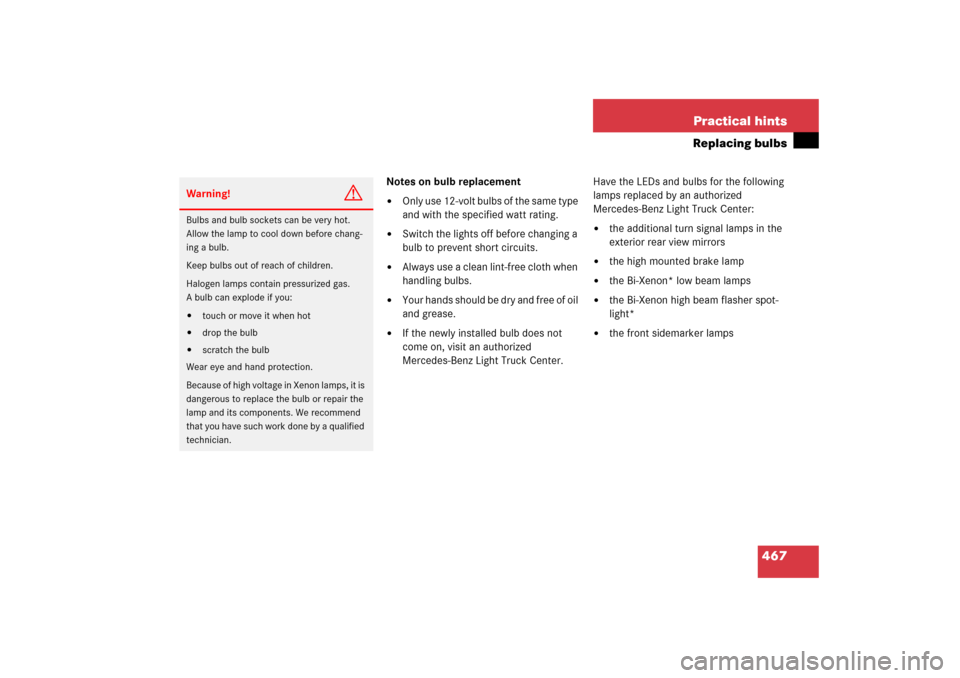
467 Practical hints
Replacing bulbs
Notes on bulb replacement�
Only use 12-volt bulbs of the same type
and with the specified watt rating.
�
Switch the lights off before changing a
bulb to prevent short circuits.
�
Always use a clean lint-free cloth when
handling bulbs.
�
Your hands should be dry and free of oil
and grease.
�
If the newly installed bulb does not
come on, visit an authorized
Mercedes-Benz Light Truck Center.Have the LEDs and bulbs for the following
lamps replaced by an authorized
Mercedes-Benz Light Truck Center:
�
the additional turn signal lamps in the
exterior rear view mirrors
�
the high mounted brake lamp
�
the Bi-Xenon* low beam lamps
�
the Bi-Xenon high beam flasher spot-
light*
�
the front sidemarker lamps
Warning!
G
Bulbs and bulb sockets can be very hot.
Allow the lamp to cool down before chang-
ing a bulb.
Keep bulbs out of reach of children.
Halogen lamps contain pressurized gas.
A bulb can explode if you:�
touch or move it when hot
�
drop the bulb
�
scratch the bulb
Wear eye and hand protection.
Because of high voltage in Xenon lamps, it is
dangerous to replace the bulb or repair the
lamp and its components. We recommend
that you have such work done by a qualified
technician.
Page 479 of 561
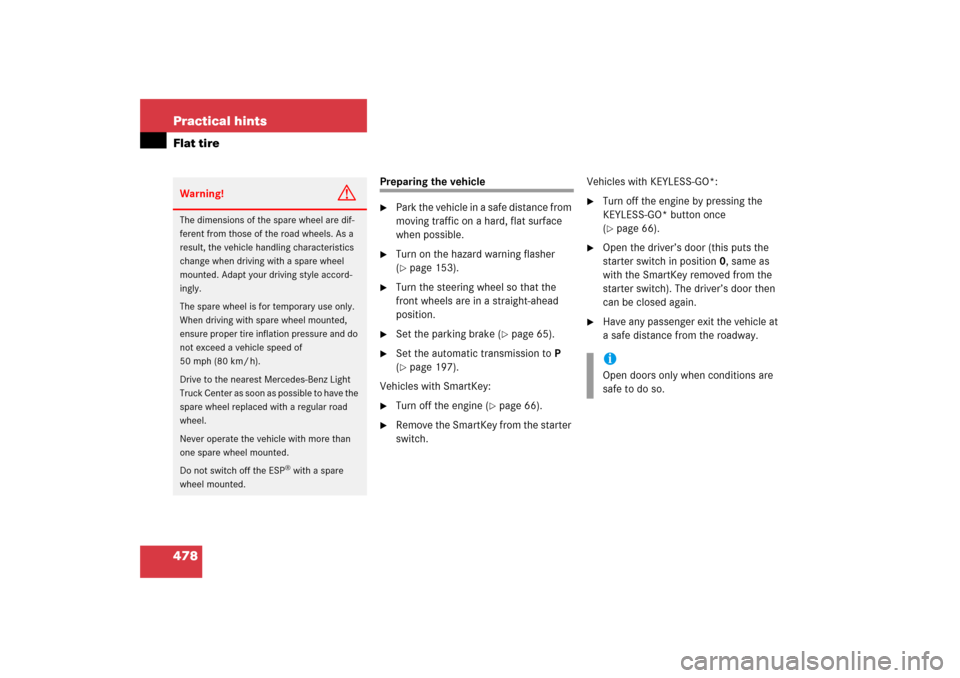
478 Practical hintsFlat tire
Preparing the vehicle�
Park the vehicle in a safe distance from
moving traffic on a hard, flat surface
when possible.
�
Turn on the hazard warning flasher
(�page 153).
�
Turn the steering wheel so that the
front wheels are in a straight-ahead
position.
�
Set the parking brake (
�page 65).
�
Set the automatic transmission to P
(�page 197).
Vehicles with SmartKey:
�
Turn off the engine (
�page 66).
�
Remove the SmartKey from the starter
switch.Vehicles with KEYLESS-GO*:
�
Turn off the engine by pressing the
KEYLESS-GO* button once
(�page 66).
�
Open the driver’s door (this puts the
starter switch in position 0, same as
with the SmartKey removed from the
starter switch). The driver’s door then
can be closed again.
�
Have any passenger exit the vehicle at
a safe distance from the roadway.
Warning!
G
The dimensions of the spare wheel are dif-
ferent from those of the road wheels. As a
result, the vehicle handling characteristics
change when driving with a spare wheel
mounted. Adapt your driving style accord-
ingly.
The spare wheel is for temporary use only.
When driving with spare wheel mounted,
ensure proper tire inflation pressure and do
not exceed a vehicle speed of
50 mph (80 km/ h).
Drive to the nearest Mercedes-Benz Light
Truck Center as soon as possible to have the
spare wheel replaced with a regular road
wheel.
Never operate the vehicle with more than
one spare wheel mounted.
Do not switch off the ESP
® with a spare
wheel mounted.
iOpen doors only when conditions are
safe to do so.
Page 480 of 561
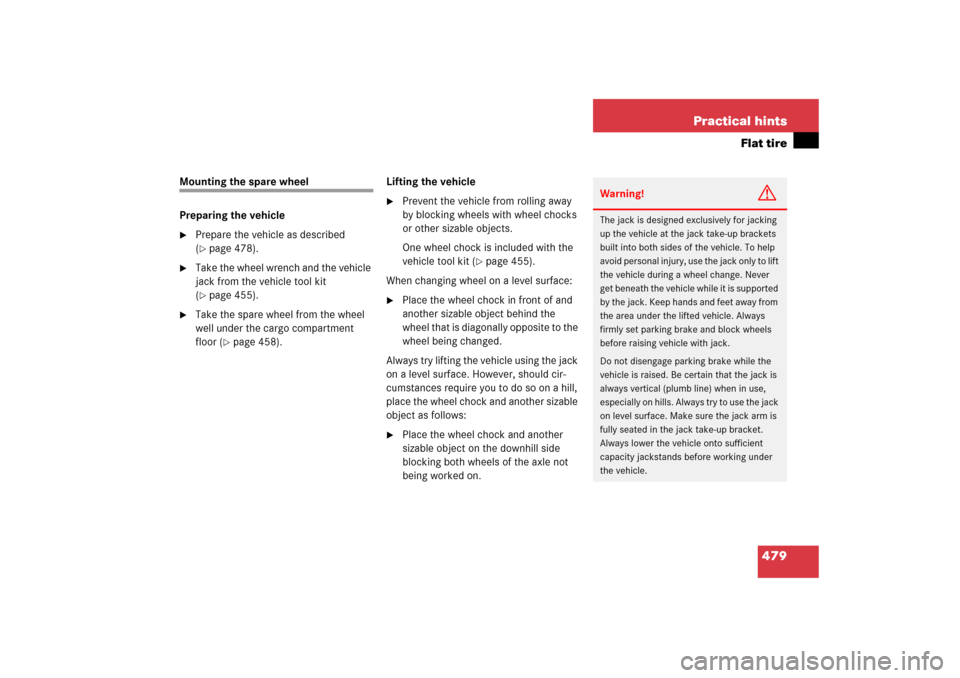
479 Practical hints
Flat tire
Mounting the spare wheel
Preparing the vehicle�
Prepare the vehicle as described
(�page 478).
�
Take the wheel wrench and the vehicle
jack from the vehicle tool kit
(�page 455).
�
Take the spare wheel from the wheel
well under the cargo compartment
floor (
�page 458).Lifting the vehicle
�
Prevent the vehicle from rolling away
by blocking wheels with wheel chocks
or other sizable objects.
One wheel chock is included with the
vehicle tool kit (
�page 455).
When changing wheel on a level surface:
�
Place the wheel chock in front of and
another sizable object behind the
wheel that is diagonally opposite to the
wheel being changed.
Always try lifting the vehicle using the jack
on a level surface. However, should cir-
cumstances require you to do so on a hill,
place the wheel chock and another sizable
object as follows:
�
Place the wheel chock and another
sizable object on the downhill side
blocking both wheels of the axle not
being worked on.
Warning!
G
The jack is designed exclusively for jacking
up the vehicle at the jack take-up brackets
built into both sides of the vehicle. To help
avoid personal injury, use the jack only to lift
the vehicle during a wheel change. Never
get beneath the vehicle while it is supported
by the jack. Keep hands and feet away from
the area under the lifted vehicle. Always
firmly set parking brake and block wheels
before raising vehicle with jack.
Do not disengage parking brake while the
vehicle is raised. Be certain that the jack is
always vertical (plumb line) when in use,
especially on hills. Always try to use the jack
on level surface. Make sure the jack arm is
fully seated in the jack take-up bracket.
Always lower the vehicle onto sufficient
capacity jackstands before working under
the vehicle.
Page 482 of 561

481 Practical hints
Flat tire
Removing the wheel
1Alignment bolt�
Unscrew upper-most wheel bolt and
remove.
�
Replace this wheel bolt with alignment
bolt1 supplied in the vehicle tool kit
(�page 454).
�
Remove the remaining wheel bolts.
�
Remove the wheel.Mounting the spare wheel
1Wheel bolt for 18" and 19" light alloy
wheels
2Wheel bolt for 17" light alloy wheels or
collapsible tire (located in trunk with
spare wheel)
Warning!
G
The jack is intended only for lifting the
vehicle briefly for wheel changes. It is not
suited for performing maintenance work
under the vehicle.�
Never start the engine when the vehicle
is raised.
�
Never lie down under the raised vehicle.
!Do not place wheel bolts in sand or dirt.
This could result in damage to the bolts
and wheel hub threads.
!Wheel bolts2 must be used when
mounting the spare wheel with collaps-
ible tire. The use of any wheel bolts oth-
er than wheel bolts2 for the spare
wheel with collapsible tire will physical-
ly damage the vehicle’s brakes.
Page 484 of 561
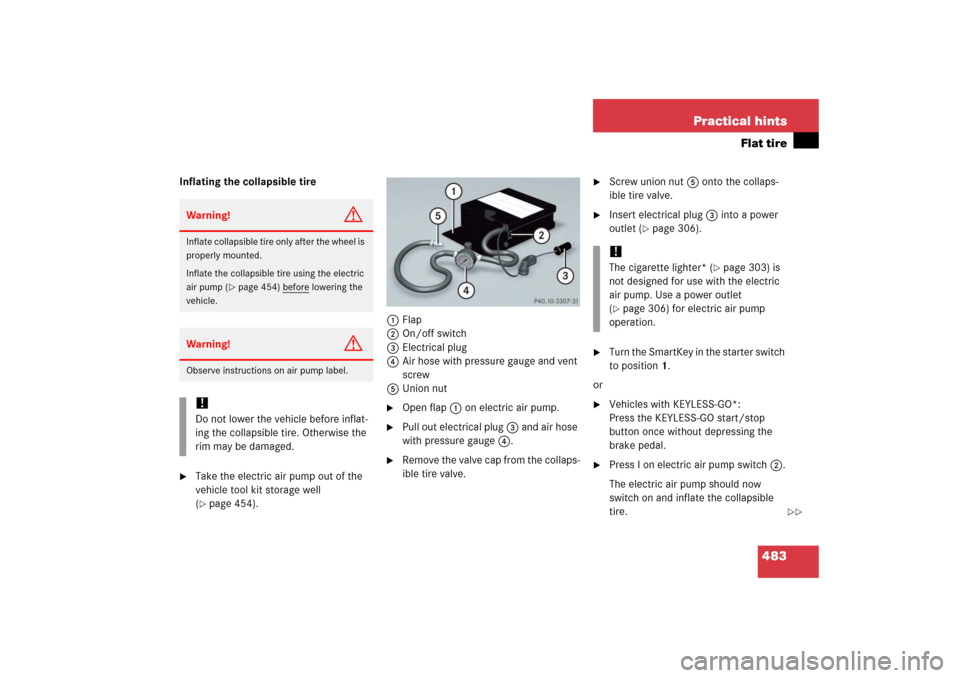
483 Practical hints
Flat tire
Inflating the collapsible tire�
Take the electric air pump out of the
vehicle tool kit storage well
(�page 454).1Flap
2On/off switch
3Electrical plug
4Air hose with pressure gauge and vent
screw
5Union nut
�
Open flap 1 on electric air pump.
�
Pull out electrical plug 3 and air hose
with pressure gauge 4.
�
Remove the valve cap from the collaps-
ible tire valve.
�
Screw union nut 5 onto the collaps-
ible tire valve.
�
Insert electrical plug 3 into a power
outlet (
�page 306).
�
Turn the SmartKey in the starter switch
to position1.
or
�
Vehicles with KEYLESS-GO*:
Press the KEYLESS-GO start/stop
button once without depressing the
brake pedal.
�
Press I on electric air pump switch 2.
The electric air pump should now
switch on and inflate the collapsible
tire.
Warning!
G
Inflate collapsible tire only after the wheel is
properly mounted.
Inflate the collapsible tire using the electric
air pump (
�page 454) before
lowering the
vehicle.
Warning!
G
Observe instructions on air pump label.!Do not lower the vehicle before inflat-
ing the collapsible tire. Otherwise the
rim may be damaged.
!The cigarette lighter* (
�page 303) is
not designed for use with the electric
air pump. Use a power outlet
(
�page 306) for electric air pump
operation.
��
Page 485 of 561
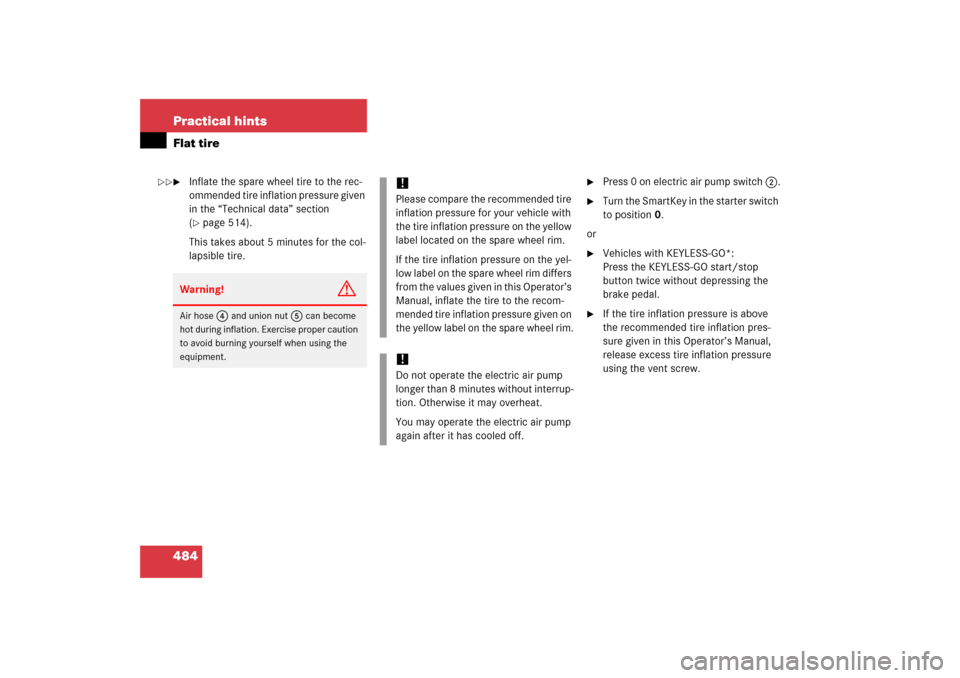
484 Practical hintsFlat tire�
Inflate the spare wheel tire to the rec-
ommended tire inflation pressure given
in the “Technical data” section
(�page 514).
This takes about 5 minutes for the col-
lapsible tire.
�
Press 0 on electric air pump switch 2.
�
Turn the SmartKey in the starter switch
to position0.
or
�
Vehicles with KEYLESS-GO*:
Press the KEYLESS-GO start/stop
button twice without depressing the
brake pedal.
�
If the tire inflation pressure is above
the recommended tire inflation pres-
sure given in this Operator’s Manual,
release excess tire inflation pressure
using the vent screw.
Warning!
G
Air hose
4
and union nut
5
can become
hot during inflation. Exercise proper caution
to avoid burning yourself when using the
equipment.
!Please compare the recommended tire
inflation pressure for your vehicle with
the tire inflation pressure on the yellow
label located on the spare wheel rim.
If the tire inflation pressure on the yel-
low label on the spare wheel rim differs
from the values given in this Operator’s
Manual, inflate the tire to the recom-
mended tire inflation pressure given on
the yellow label on the spare wheel rim.!Do not operate the electric air pump
longer than 8 minutes without interrup-
tion. Otherwise it may overheat.
You may operate the electric air pump
again after it has cooled off.
��
Page 491 of 561
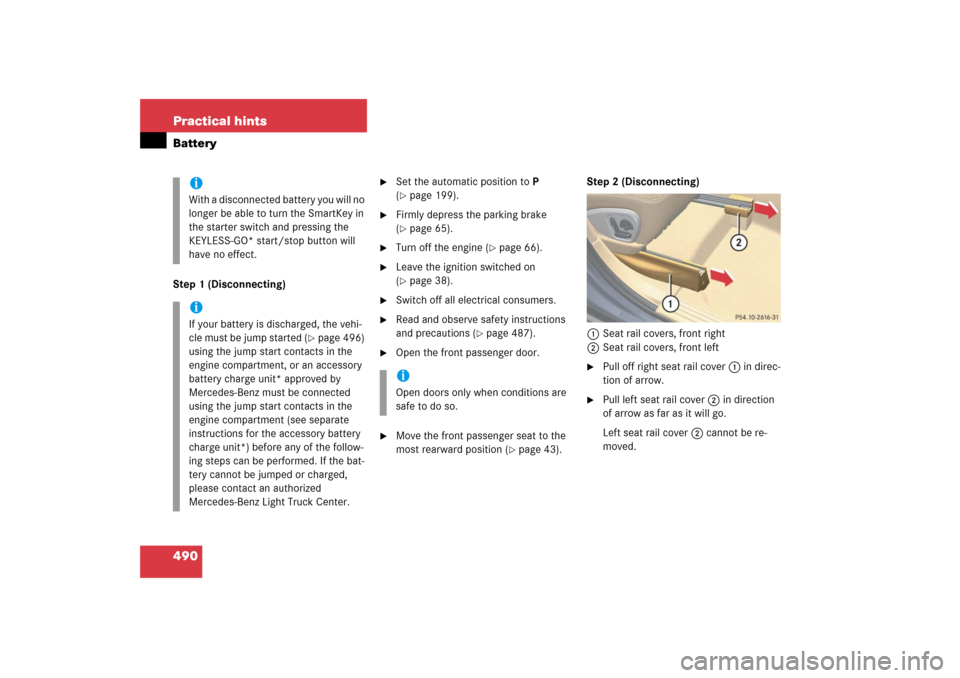
490 Practical hintsBatteryStep 1 (Disconnecting)
�
Set the automatic position to P
(�page 199).
�
Firmly depress the parking brake
(�page 65).
�
Turn off the engine (
�page 66).
�
Leave the ignition switched on
(�page 38).
�
Switch off all electrical consumers.
�
Read and observe safety instructions
and precautions (
�page 487).
�
Open the front passenger door.
�
Move the front passenger seat to the
most rearward position (
�page 43).Step 2 (Disconnecting)
1Seat rail covers, front right
2Seat rail covers, front left
�
Pull off right seat rail cover 1 in direc-
tion of arrow.
�
Pull left seat rail cover 2 in direction
of arrow as far as it will go.
Left seat rail cover 2 cannot be re-
moved.
iWith a disconnected battery you will no
longer be able to turn the SmartKey in
the starter switch and pressing the
KEYLESS-GO* start/stop button will
have no effect.iIf your battery is discharged, the vehi-
cle must be jump started (
�page 496)
using the jump start contacts in the
engine compartment, or an accessory
battery charge unit* approved by
Mercedes-Benz must be connected
using the jump start contacts in the
engine compartment (see separate
instructions for the accessory battery
charge unit*) before any of the follow-
ing steps can be performed. If the bat-
tery cannot be jumped or charged,
please contact an authorized
Mercedes-Benz Light Truck Center.
iOpen doors only when conditions are
safe to do so.